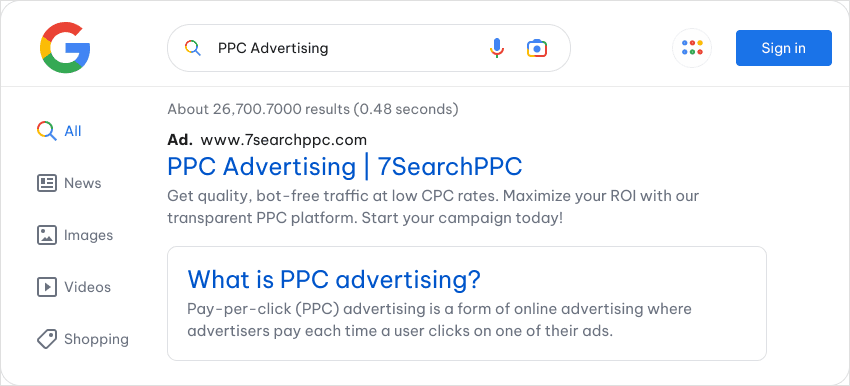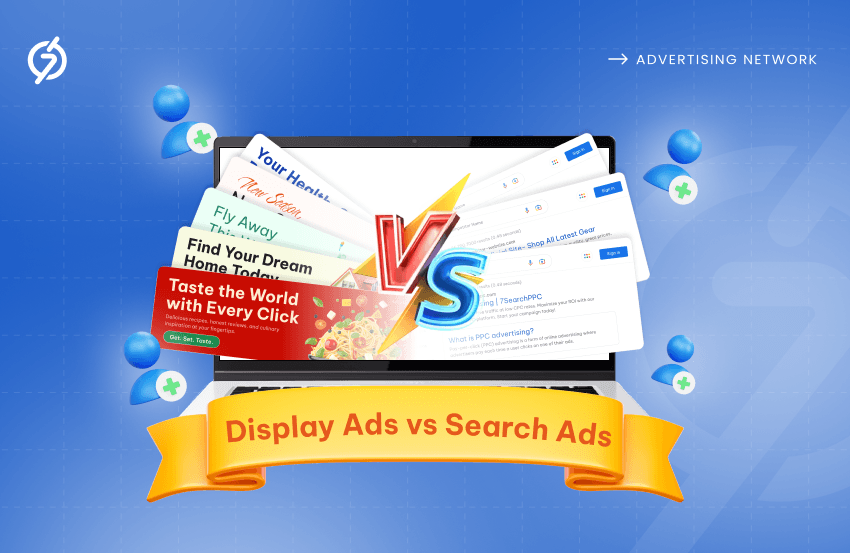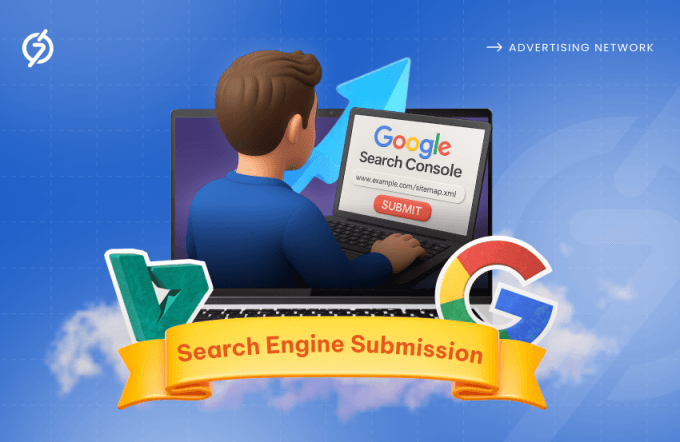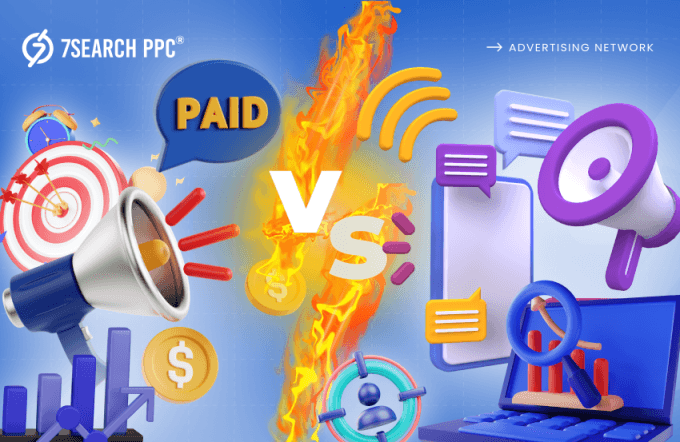Every advertiser hits this crossroads at some point: display ads or search ads? Both these ads live under the digital advertising umbrella, but they behave in totally different ways. One targets users actively searching for something; the other puts your brand in front of people before they even start looking.
If you are also stuck trying to decide which one is right for your ad campaign, join us—we are here to help you figure it out.
In this blog, we’ll explore everything about display ads vs search ads: the key differences, how they work, when to use each one, and more.
Display Ads vs Search Ads: What They Mean
Display ads and Search ads are both heroes in paid advertising—but only for those who understand their powers. So first, understand what they are.
What are Display Ads?

(A representation of what a display ad looks like.)
A rectangular or square ad format with a bright color, attractive visuals, and action-oriented text — this kind of introduction is enough to make anyone guess that it is about display ads.
These ads are visually driven and appear on websites, blogs, apps, or social media platforms. Advertisers use them in ad campaigns to promote a product, service, or brand. Online display ads are designed to catch the audience’s attention while they are browsing and help advertisers engage potential customers at different stages of the buying journey.
For example, you can target customers who are in the early consideration phase—such as those reading a blog to gather information. You can also target those who have placed items in their cart but are still deciding whether to complete the purchase.
Online display ads come in various types, but the most common ones are as follows:
- Banner ads
- Native ads
- Popunder ads
- Video Ads
- In-page push ads
Full scoop here: The Ultimate Guide on Display Ads 2025
What are Search Ads?

(An illustration of what a search ad looks like.)
Search ads are the online ads primarily displayed on search engines like Google or its search partners’ sites, such as Ask.com or Lycos.com. These are text-based ads that appear in response to specific search queries. Since they are triggered by user intent, they fall under the category of pull advertising—meaning the ads “pull” the attention of users by appearing when certain keywords are searched.
There are three main elements of search ads:
- Headline
- Display URL
- Description Text
Explore more: 7SearchPPC Text Ads: A Better Option Over Google Search Ads
Key Differences Between Search vs Display Ads
So, now that you understand the meaning of search ads and display ads, the time has come to show the real differences between them. We have created a comparison table of display ads vs search ads on the following aspects.
| Aspect | Search Ads | Display Ads |
|---|---|---|
| Placement | Appears on search engine results pages (e.g., Google) when users type relevant keywords. | Appears on websites, blogs, apps, or videos, often in the form of banners, popunders, or native ads. |
| Targeting | Based on user search intent and specific keywords. | Based on demographics, interests, behavior, and browsing history. |
| Format | Text-based ads (headlines, descriptions, URLs). | Visual-based ads (images, videos, rich media). |
| Ad Frequency | Limited to the search query; shown when relevant search terms are entered. | Can be shown multiple times across different sites or apps to the same user. |
| Creative Flexibility | Limited to text and basic URLs. | High flexibility with rich visuals and interactive media. |
| User Intent | Intent-driven; users are actively searching for something. | Awareness-driven; users are passively browsing content. |
| Type of Advertising | Pull Advertising | Push Advertising |
The Right Scenarios for Choosing Display Ads vs Search Ads
Both search advertising and display advertising are beneficial for advertisers. There is no doubt about that, but the right approach for the right situation really matters. Here is a breakdown of scenarios to help you decide when to choose display ads or search ads.
In What Situations Should You Use Display Ads?
Display advertisements perform well, but only when used effectively. Here are some scenarios where online display ads can work well.
1) When People are Less Aware of Your Brand
81% of consumers won’t consider making a purchase unless they trust the brand (source: Exploding Topics). And to generate trust, you need to step on the first rung called ‘brand awareness.
If your brand is new to people or they haven’t heard of you much, display ads are the best way to introduce yourself. This ad format helps you capture attention and inform potential audiences about your brand, products, or services. Consistently showing display ads on websites or blogs increases brand awareness over time.
Read more: How To Build and Measure Brand Awareness?
2) When You Want to Show Limited-Time or Seasonal Offers

The next scenario where you should use display ads is when you want to launch amazing offers.
Are you planning to surprise your audience with a Black Friday sale, holiday discount, or exclusive deal on your products and services? Display ads are the perfect way to make it work.
These ads combine the power of text and visuals, so you can not only engage your audience but also hit an urgency factor. Using phrases like “limited-time only” alongside high-quality visuals (such as animations or GIFs) makes viewers feel like they will lose out if they wait too long.
3) When You Need to Remind Your Audience
There are many instances where businesses see visitors come to their website but take no action. In other cases, customers may add products to their cart but leave without completing the purchase. This is where display ads can help.
They serve as a friendly nudge to your audience, reminding them: “Hey, we are missing you! Come back to grab the latest offers waiting for you.”
Learn More: Retargeting Ads: Reach your Target Audience With PPC Ad Campaigns
4) When You Aim to Attract a Wider Audience Across Multiple Platforms
If your goal is to reach a broad audience, display ads are a smart choice that you can bet on. These ads appear across the platforms where your audience is most active worldwide—websites, blogs, apps, social media, and more. Whenever they interact with your ad, they will surely visit your website or landing page.
In What Situations Should You Use Search Ads?
Below are the ideal scenarios where online search ads can make a significant impact.
1) When Users are Actively Searching for Your Product or Service
Search ads work best when people are already looking for what you offer. Suppose you run an online shoe store named GenMillAlpha. Your store has various collections such as Jordan, Branded Sports Shoes, and Casual Shoes. If someone searches for “Best Jordan shoes under $1000” or “Buy sports shoes online,” they are looking for what you offer — and you can capture their attention with a targeted search ad. These ads provide an opportunity to appear on relevant keywords and offer exactly what they need.
2) When You Have a Clear Conversion Goal
If you want people to do something specific — like buy a product, book a service, or sign up — search ads are a smart move. You can target the right people with the intent-driven keywords. Paid search advertising allows you to display text-based ads by bidding on keywords that reflect specific actions or intentions of your audience.
Find Out More: To Get More Conversions With Top Irresistible Call To Action Examples
3) When You Want to Appear for Branded or Competitor Terms

Sometimes, it’s not just about general searches. You might want to show up when people search for your brand name—or even your competitor’s. For example, if someone types in your competitor’s name, your search ad can still appear with an offer or a reason to check you out instead. It’s a strategic move to protect your brand space and also win over potential customers who are exploring other options.
4) When You Have an Edge Over Competitors in Bidding
Paid search advertising works well when your search ad and website are better than your competitors’. Google gives you something called a Quality Score based on how helpful and relevant your ad is. A higher score means you can often pay less and still show up higher in search results. So if your ad is strong, your website is solid, and you are ready to invest a bit, you can beat the competition—even if they’re spending more.
Display Ads vs Search Ads: Which One is Right for You?
Search ad vs Display ad — which one is better?
Honestly, both display ads and search ads are effective. We can’t tell which one is better, as each of these ads has its own unique advantages. However, if you want to know which to choose, we have one answer: it really just comes down to what your goals are with digital advertising.
If you’re looking to build awareness and reach people while they are browsing websites, apps, or blogs, display ads are your friend. On the other hand, if you want to catch people who are actively searching for something you offer, search ads are the way to go.
And here’s a little secret: if your marketing budget allows, why not use both? Running display and search ads together lets you cover all bases—whether your audience is scrolling through their favorite sites or typing in their next purchase query on Google.
Conclusion
The display ads vs search ads debate isn’t about which is better—it’s about understanding the difference and choosing according to your digital advertising goals. Display ads are ideal for spreading awareness and engaging a broader audience, while search ads are perfect for targeting users with clear intent. Both have unique strengths. So instead of picking one over the other, consider how they can complement each other to give your ad campaign more power and reach.
Frequently Asked Questions (FAQs)
What is search advertising?
Ans. Search advertising is an advertising approach where text-only ads are shown on search engine results when someone types in specific keywords.
What is display advertising?
Ans. Display advertising is a form of online advertising that features visual-based ads on websites, apps, blogs, and social media platforms.
Display ads vs search ads: Is there any difference?
Ans. Yes, when it comes to advertising, display ads vs search ads are quite different. Search ads appear when people are actively searching for something, while display ads show up while users are browsing content online.
When comparing display ads vs search ads, which is more expensive?
Ans. It depends on your goals and targeting. Search ads may have a higher cost-per-click because they target people with strong buying intent. Display ads often cost less but may require more impressions to see results.
Can I use both display ads and search ads at the same time?
Ans. Yes! Using both display ads and search ads together can help you reach a wider audience—those who are browsing and those who are searching.

















